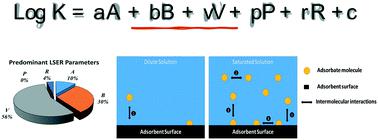当前位置:
X-MOL 学术
›
Environ. Sci.: Water Res. Technol.
›
论文详情
Our official English website, www.x-mol.net, welcomes your feedback! (Note: you will need to create a separate account there.)
Linear solvation energy relationship development for adsorption of synthetic organic compounds by carbon nanomaterials: an overview of the last decade
Environmental Science: Water Research & Technology ( IF 5 ) Pub Date : 2020-09-18 , DOI: 10.1039/d0ew00644k Onur G. Apul 1, 1, 2, 3, 4 , Francois Perreault 4, 5, 6, 7 , Gamze Ersan 4, 8, 9, 10 , Tanju Karanfil 4, 8, 9, 10
Environmental Science: Water Research & Technology ( IF 5 ) Pub Date : 2020-09-18 , DOI: 10.1039/d0ew00644k Onur G. Apul 1, 1, 2, 3, 4 , Francois Perreault 4, 5, 6, 7 , Gamze Ersan 4, 8, 9, 10 , Tanju Karanfil 4, 8, 9, 10
Affiliation

|
The production of carbon nanomaterials has been increasing due to their outstanding properties and innovation potential in various industrial applications. Hence, their discharge into the aquatic environment from point and non-point sources is inevitable. Therefore, the natural and built aquatic environments that contain thousands of synthetic organic contaminants, would facilitate adsorptive interaction between synthetic organic molecules and carbon nanomaterial surfaces. Today's literature rapidly developed to contain a great number of adsorption data for synthetic organic compounds onto carbon nanomaterials. The availability of adsorption data enables generation of structure–activity relationships by utilizing adsorbate and adsorbent characteristics in simple/controlled aquatic solutions. These models not only create practical predictive tools but also provide mechanistic insights about intermolecular interactions between organic molecules and carbon nanomaterials. This review analyzes 86 linear solvation energy relationship models published in the last decade. Our work summarizes and compares key independent variables associated with adsorbate properties (e.g., molecular size, H-bonding ability, polarizability) and identifies critical factors for selecting dependent variables (e.g., adsorbent characteristics, saturation concentration). The study also discusses intermolecular interactions unraveled by the modeling efforts at different adsorbate concentrations. This work aims to provide an analysis of literature to identify key gaps in today's model training efforts and list guiding principles for ongoing and future linear solvation energy relationship studies.
中文翻译:

碳纳米材料吸附合成有机化合物的线性溶剂能关系的发展:过去十年的概述
碳纳米材料的优异性能和在各种工业应用中的创新潜力使其产量不断增加。因此,它们不可避免地从点源和非点源排放到水生环境中。因此,包含成千上万个合成有机污染物的自然和人造水生环境将促进合成有机分子与碳纳米材料表面之间的吸附相互作用。当今的文献迅速发展,包含了许多合成有机化合物在碳纳米材料上的吸附数据。吸附数据的可用性可通过在简单/受控的水溶液中利用吸附物和吸附剂特性来生成结构-活性关系。这些模型不仅创建了实用的预测工具,而且还提供了有关有机分子与碳纳米材料之间的分子间相互作用的力学见解。这篇评论分析了过去十年中发布的86个线性溶剂化能量关系模型。我们的工作总结并比较了与吸附物性能相关的关键自变量(例如分子大小,氢键能力,极化率),并确定选择因变量的关键因素(例如吸附剂特性,饱和浓度)。这项研究还讨论了在不同吸附物浓度下通过建模努力揭示的分子间相互作用。这项工作旨在提供文献分析,以找出当今模型培训工作中的主要差距,并列出正在进行和将来进行的线性溶剂化能量关系研究的指导原则。
更新日期:2020-09-23
中文翻译:

碳纳米材料吸附合成有机化合物的线性溶剂能关系的发展:过去十年的概述
碳纳米材料的优异性能和在各种工业应用中的创新潜力使其产量不断增加。因此,它们不可避免地从点源和非点源排放到水生环境中。因此,包含成千上万个合成有机污染物的自然和人造水生环境将促进合成有机分子与碳纳米材料表面之间的吸附相互作用。当今的文献迅速发展,包含了许多合成有机化合物在碳纳米材料上的吸附数据。吸附数据的可用性可通过在简单/受控的水溶液中利用吸附物和吸附剂特性来生成结构-活性关系。这些模型不仅创建了实用的预测工具,而且还提供了有关有机分子与碳纳米材料之间的分子间相互作用的力学见解。这篇评论分析了过去十年中发布的86个线性溶剂化能量关系模型。我们的工作总结并比较了与吸附物性能相关的关键自变量(例如分子大小,氢键能力,极化率),并确定选择因变量的关键因素(例如吸附剂特性,饱和浓度)。这项研究还讨论了在不同吸附物浓度下通过建模努力揭示的分子间相互作用。这项工作旨在提供文献分析,以找出当今模型培训工作中的主要差距,并列出正在进行和将来进行的线性溶剂化能量关系研究的指导原则。


























 京公网安备 11010802027423号
京公网安备 11010802027423号